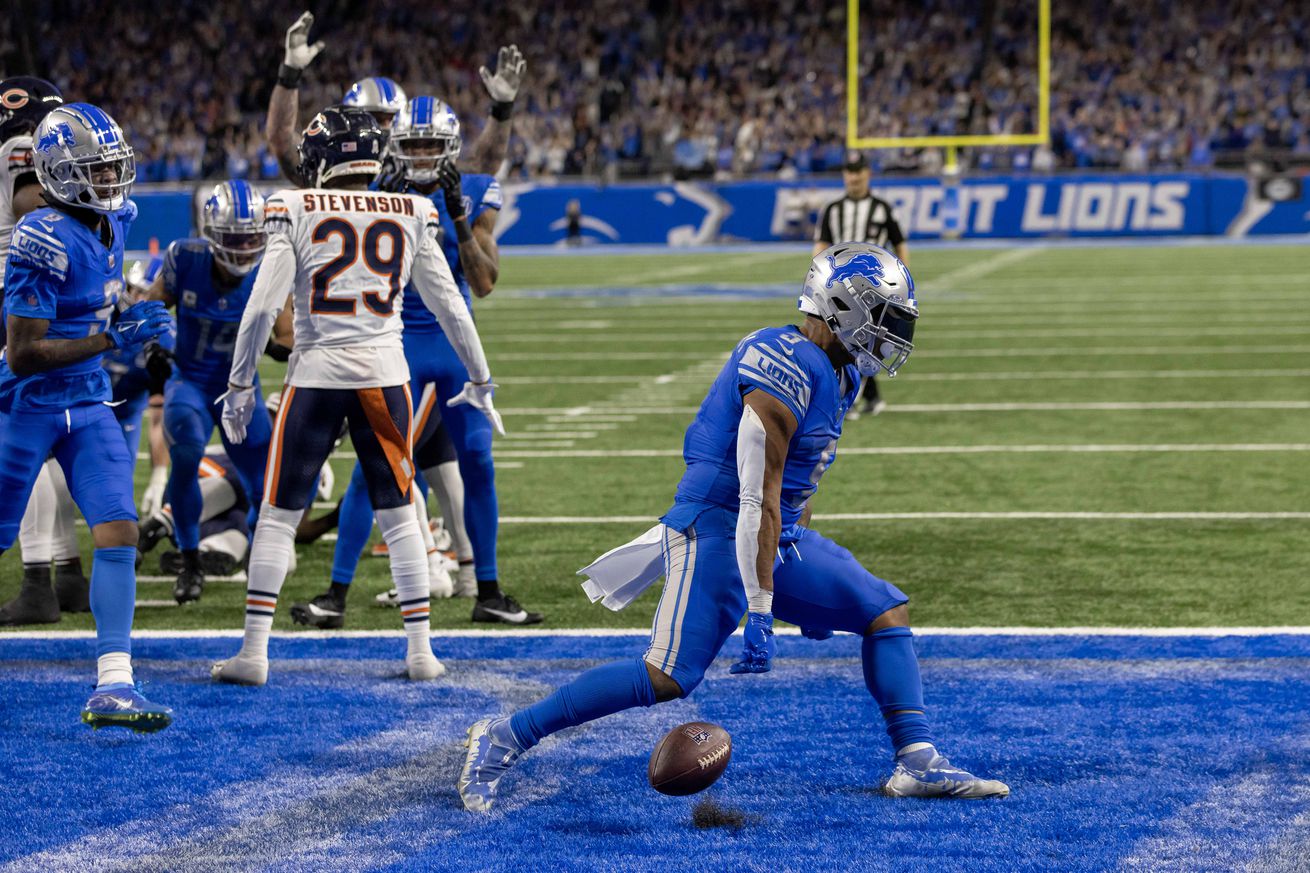
Our Lions vs. Bears statistical breakdown, matchup advantages, preview and PREDICTION!
The Detroit Lions take on the Chicago Bears on Thanksgiving Day. While the records (10-1 vs. 4-6) and the Vegas betting line (Lions by 10.5) suggest this could be another blowout in Detroit’s favor, some key injuries on the Lions’ side could even this one out.
Let’s take a closer look at this Week 13 matchup, break down the statistical edges, and offer a prediction in our Lions vs. Bears On Paper preview.
Lions pass offense (10th in DVOA) vs. Bears pass defense (10th)
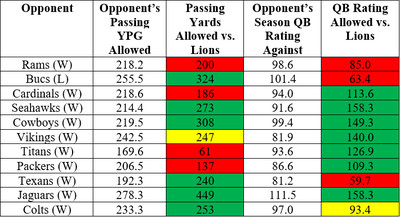
That Texans game is officially a distant memory as the Lions pass offense is back to its normal productive self. While last week against the Colts wasn’t their best performance, Goff still completed 72.2 percent of his passes for a respectable 7.5 yards per attempt. It was just the second game all season he didn’t find the end zone.
But for the season, this has been a top-10 unit bordering on a top-five passing attack. Here’s the bullet-pointed stats:
- 9.0 yards per attempt (first)
- 111.5 passer rating (first)
- 0.254 dropback EPA (second)
- 52.9% success rate (first)
- 65% pass block win rate (ninth)
- 68.7 PFF pass blocking grade (17th)
The pass blocking statistics are perhaps the only thing mildly concerning about this unit. They haven’t been as good of a blocking unit as you may think given Detroit’s offensive line reputation. They’re 16th in pressure rate (34.4%), but the Lions have actually dealt with the pressure amazingly. They’ve only allowed 22 sacks on the season (seventh) and Goff ranks seventh in EPA/dropback (-0.21) and second in passer rating (99.4) while under pressure.
That could be important this week, as Dan Skipper is likely to play at tackle with Taylor Decker unlikely to play. Skipper has the team’s worst pass blocking grade (44.1) among offensive linemen, allowing five pressures in just 50 pass blocking snaps this year. For comparison’s sake, Penei Sewell has allowed 16 pressures in 352 snaps.
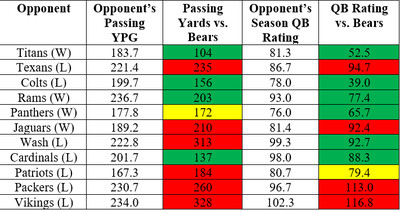
For most of the season, the Bears pass defense has been their biggest strength. For the season, they rank:
- 16th in yards per attempt (7.0)
- Eighth in passer rating (84.1)
- Seventh in dropback EPA (-0.042)
- 11th in success rate (43.8%)
- 20th in pass rush win rate (40%)
- 12th in PFF pass rush grade (71.0)
But in the past two weeks against divisional opponents, they’ve struggled. Combined, Jordan Love and Sam Darnold went 35-of-51 (68.6%) for 591 yards (11.6 Y/A), three touchdowns and an interception for a 119.0 passer rating. I don’t have a clear reason for the struggles, but it’s certainly something worth keeping an eye on. It could be as something as simple as the Bears are finally facing some good passing attacks after months of subpar quarterback play.
Notably, the Bears pass rush has not been particularly good this year. The only defensive linemen with a PFF pass rush grade above 70 is defensive tackle Andrew Billings, and he has just 11 pressures on the year. Montez Sweat and Gervon Dexter lead the team with 33 pressures, but both have been inconsistent this year.
Player to watch: Jaylon Johnson. His PFF grade doesn’t reflect it (63.8), but Johnson is still a legitimate CB1 in this league. He has a very good chance of shutting down his side of the field, but Tyrique Stevenson (56.4 PFF coverage grade) has struggled on the opposite side, so the Lions could simply avoid Johnson.
Advantage: Lions +1. I’d have greater confidence in this matchup if Decker was playing, but we saw this offense struggle against the Texans when Skipper was in the starting lineup. That said, the Texans have a much better defense than the Bears—particularly when it comes to their defensive front.
Lions run offense (2nd) vs. Bears run defense (30th)
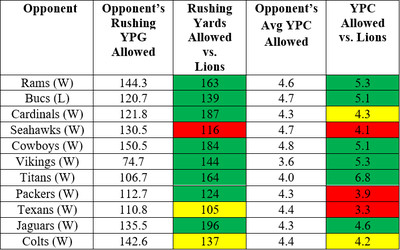
The Lions have rushed for at least 100 yards and a rushing touchdown in every single game this season, and they’ve only failed to surpass defensive averages in yards per carry three times this season.
The overall stats for this unit are outstanding. While they “only” rank eighth in yards per carry (4.7), they’re third in rush EPA (0.045) and second in success rate (45.8%). The offensive line is the engine that makes the run game purr. They rank second in run block PFF grade (76.8), first in adjusted line yards (5.14), third in power success (short yardage situations), and fifth in yards before contact.
Of course, the duo of Jahmyr Gibbs and David Montgomery have done their part. Montgomery ranks t-third in broken tackles forced (18), and ninth in yards after contact per rush (2.4). Gibbs ranks 16th and 20th in those categories, respectively.
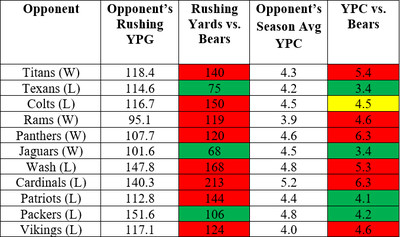
The Bears have allowed over 100 yards in eight of 11 contests and over 4.0 yards per carry in nine of 11. They’ve been particularly bad out of the bye week (post-Jaguars), which means they’re trending in the wrong direction as they prepare to face the toughest run game they’ve face all season.
For the year, the Bears rank 28th yards per carry (4.8), 20th in EPA (-0.064), 13th in success rate (38.6%), and 27th in adjusted line yards (4.89). In other words, they can get pushed around pretty significantly in the trenches, which is reflected in their 26th-ranked run stop win rate via ESPN.
Player to watch: David Montgomery.
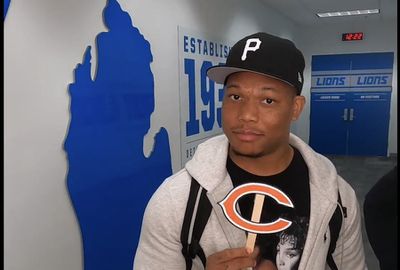
Enough said.
Advantage: Lions +3.5. Honestly, the only thing that gives me pause in this matchup with Skipper in the lineup, but he’s a better run blocker than he is a pass protector. I not only think this is a huge tilt in the Lions’ favor, but I also believe this will be Detroit’s focus on Thursday. With a short week limiting each team’s ability to create a full game plan, why not just turn this into a physical “our guys are stronger than your guys” matchup? Football at its purest.
Bears pass offense (26th) vs. Lions pass defense (1st)
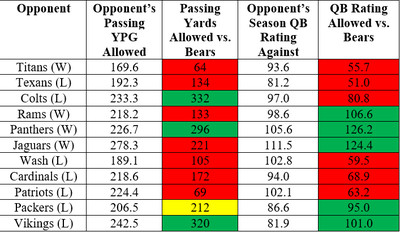
This is much like last week’s matchup in that it’s hard to feel confident about where the Bears’ passing offense is right now. Anthony Richardson looked like a refreshed quarterback off his benching for the Colts, and Caleb Williams looks much better after Chicago made a change at offensive coordinator. Williams performed well against a pair of decent defenses in the past two weeks, so there may be more validity to his “turnaround,” as Richardson didn’t live up to the billing last week.
Statistically, there have been a lot of drastic changes to the Bears’ passing attack, as outlined nicely by our own Erik Schlitt in his breakdown of Chicago’s offensive scheme :
Under Waldron, Williams took, on average, 2.9 seconds to throw his passes. But under Brown, the rookie has cut that number to 2.42 seconds. On the season, when Williams takes longer than 2.5 seconds to throw, his completion percentage is 51.7%, throwing for 1,419 yards, six touchdowns, and five interceptions. On plays where he gets rid of the ball in under 2.5 seconds, Williams averages a 77% completion percentage and has thrown for 937 yards, four touchdowns, and zero interceptions.
It’s hard to imagine the Bears changing course now since seeing so much success over the past two weeks, so Detroit should prepare for a lot of short, quick throws. In the past two week, the Bears have ranked 27th and 24th in time to throw (meaning on the shorter end).
That said, they do have a good set of receiver who are capable of creating separation and yards after the catch. D.J. Moore ranks 18th in yards after the catch.
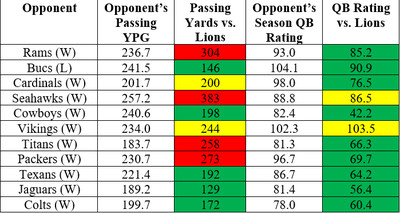
The Lions pass defense has been phenomenal all year, and they’ve finally put to bed one of my larger concerns: what happens if the interceptions dry up? In the past two weeks—granted they were against poor quarterbacks—the Lions managed only a single takeaway, but arguably posted their most impressive defensive numbers.
For the year, the Lions rank top-five in just about every category:
- Ninth in yards per attempt (6.7)
- First in passer rating (72.7)
- Third in interceptions (14)
- Seventh in passes defended (55)
- Second in dropback EPA (-0.105)
- Eighth in success rate (43.5%)
But this should be an interesting week without their top cornerback in Carlton Davis. He has the team’s best coverage grade (71.5) among Lions cornerbacks by a fairly large margin (Amik Robertson is next at 57.1). Terrion Arnold (51.7) and Kindle Vildor (35.8) have struggled this year. It’s unclear how the Lions will respond this week, but that will undoubtedly be their biggest weakness in this matchup.
Player to watch: Keenan Allen. Allen hasn’t found his groove in Chicago yet, so maybe this is more based on reputation than anything else, but I can’t shake Allen’s last game against Detroit: an 11-catch performance for 175 yards and a pair of TDs last year with the Chargers . I know. It’s a different team and a different Lions defense, but I can’t shake it.
Advantage: Lions +1.5. I’m going modest here because of uncertainty surrounding the “new” Bears offense and the Lions’ injury situation. Still, we’re dealing with a rookie quarterback and a shaky offensive line. At some point, Williams is going to make a mistake that could cost the Bears the game, whether it’s taking an unnecessary sack or throwing a bad pick—although he’s been better about avoiding both those trap falls lately.
Bears run offense (19th) vs. Lions run defense (3rd)
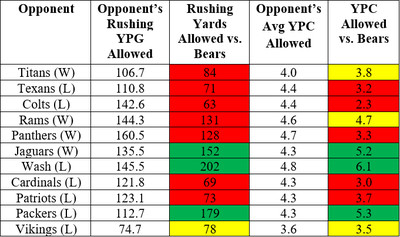
It was a dreadful start to the D’Andre Swift/Chicago Bears era, but they seemed to have found their groove a little bit. The Bears running game is still not good, but they’re probably more average than terrible. Leaning into Williams’ ability to scramble or run RPOs have helped in recent weeks, but the overall numbers are still relatively uninspiring.
Chicago ranks 23rd in yards per carry (4.1), 17th in EPA (-0.085) and 20th in success rate. They’re terrible in power situations (25th) and rank 20th in stuffed percentage (19%).
Interestingly, it may not be completely on the offensive line. ESPN has them ranked fourth in run block win rate and PFF ranks them 12th in run blocking grade (although they’re 28th in adjusted line yards).
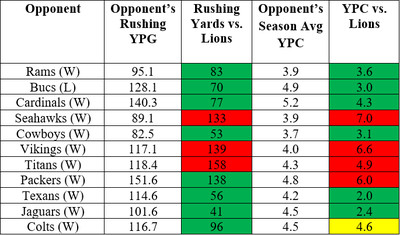
The Lions run defense remains pretty darn stout. Even with the unique test of Anthony Richardson, the Lions slowed Indy’s rushing attack after allowing the second-year quarterback to see some success in his first drive.
For the season, Detroit ranks 16th in yards per carry allowed (4.3), but fourth in rush EPA (-0.173), third in success rate (33.8%), and 13th in stuffed rate (19%).
Player to watch: D’Andre Swift. Sure, we can play the RB revenge game on both sides! While Swift has seen his fair share of struggles this year, it’s worth remembering just how explosive he can be if he finds open field. Per Next Gen Stats, he has 37 rushes where he’s reached 15 miles per hour, which ranks 11th—just behind Jahmyr Gibbs.
Advantage: Lions +2. Again, the Lions seem to have a pretty clear advantage here, and they haven’t been fazed by the injuries to their defensive front and their linebacking corps. A mobile quarterback is always the equalizer here, so I can’t go too far in Detroit’s favor here, but it’s clear their unit is stronger.
Last week’s prediction
I don’t feel too bad about my 34-20 Lions prediction, even if it wasn’t particularly close to the 24-6 final score. I still got the team and spread right, meaning On Paper is now 10-1 overall and 8-3 against the spread. Detroit’s offense was a little less successful than I expected, as I possibly underestimated the Colts’ run defense. I don’t find there are any necessary adjustments to make this week based on that performance, though.
In the comment section, the closest prediction was BigFan19, who predicted 27-3. Here is your prize.

I’m sorry, BigFan19, but I’m going to use this platform to complain something. The Lions announced they’re wearing their “blueberries” uniform combination for Thanksgiving, which I highly object to. I normally don’t get too involved with uniform talk, but if you aren’t wearing the throwbacks for the Thanksgiving Day Classic (against one of the most historical franchises) what’s the point in having them at all? This is the perfect week for them.
I’m being overdramatic, and the throwbacks are still available to use, but I think they should be worn EVERY Thanksgiving.
This week’s prediction
The Lions come out with a +8 advantage, which falls right between the edge they had on the Colts (+7.5) and the Jaguars (+8.5). That feels about right.
Based on intuition, I think this will be the closest of the three games for two reasons: the Bears offense is trending in the right direction, and the Lions have some seriously impactful injuries. I’ve been saying all week, I think this is going to be a one-score game.
But I think going through this data has brought me back a little closer to reality. I know the Bears have played their recent opponents close, and they should probably have an extra win or two, but the Lions are clearly the better team and it isn’t particularly close. So I’m sticking with the numbers. Lions 34, Bears 17.
